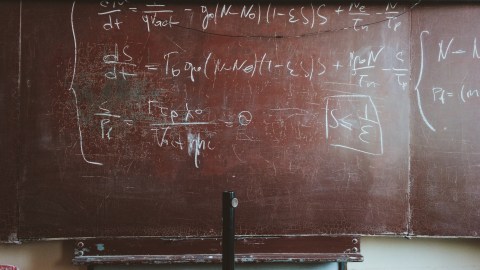Remembering George Dantzig: The real Will Hunting

Photo credit: oman Mager on Unsplash
- One of the iconic scenes from Good Will Hunting shows Matt Damon’s character anonymously solving a nigh-impossible math problem on a blackboard at the university where he works as a janitor.
- This story, while modified for the purposes of the film, actually happened.
- George Dantzig, who would later become a famous mathematician, was late to his graduate statistics class one day when he saw two statistical problems on a blackboard that he mistook for homework.
Good Will Hunting Scene Math Problem
If you’ve ever seen Good Will Hunting, you’re probably familiar with the setup. Matt Damon’s character, Will Hunting, is a young Bostonian with a quintessentially ’90s haircut working as a janitor at MIT. A professor at MIT has set up a challenging math problem on the blackboard outside his office; Will solves it anonymously and easily, even though he doesn’t attend the college.
The professor sets up another, even harder math problem. Again, Will solves it, although the professor catches him in the act this time, prompting Will to flee. When the professor asks his name, assuming the janitor is vandalizing his blackboard, Will responds “Fahk you,” and disappears. The professor is shocked to discover that the janitor has written the correct answer on the blackboard.
It’s pure Hollywood, improbable and endearing. But this particular scene actually has its roots in reality, although the protagonist in this case didn’t have a strong jawline and huge forehead. Instead, it was based on an anecdote from the life of the legendary math student George Bernard Dantzig.
Luckily late to class
Dantzig, who died in 2005, was a celebrated mathematician best known for his development of the simplex algorithm, a popular algorithm used in linear programming to find the optimal solution to problems that can be described through linear mathematics; for example, how to maximize profits and minimize losses, or how to determine the best diet for an army at the least cost. But part of what made his work in this field feasible was being late for class one day when he was a student.
Dantzig was studying statistics under professor Jerzy Neyman at UC Berkley’s graduate program. In an interview, Dantzig explained that “I arrived late one day at one of Neyman’s classes. On the blackboard there were two problems that I assumed had been assigned for homework. I copied them down. A few days later I apologized to Neyman for taking so long to do the homework — the problems seemed to be a little harder than usual.”
Six weeks later, Neyman rushed over to Dantzig’s house and excitedly told him that he had just written an introduction to “one of your papers. Read it so I can send it out right away for publication.” Dantzig had no idea what Neyman was talking about until he explained that the two problems on the blackboards were famously unsolved statistical problems — not homework at all.
Later on in his graduate degree, Dantzig was struggling to come up with a thesis topic. Allegedly, when Dantzig told Neyman this, the professor shrugged it off and told him to put the two math problems in a binder for submission — they would count as his thesis.
How the story spread
Years later, Dantzig was an accomplished computer scientist and mathematician when his colleague Don Knuth stopped him. “Hey, George,” he said. “I was visiting in Indiana recently and heard a sermon about you in church. Do you know that you are an influence on Christians of middle America?”
As it turns out, Dantzig’s story had been making the rounds as an example of the power of positive thinking. Initially, a Lutheran televangelist in Los Angeles had picked up the story, albeit with major embellishments. The televangelist claimed that the problems had stumped even Einstein and that Dantzig’s professor hired him on the spot after seeing the correct solutions. Despite these exaggerations, the moral of the story remained the same. Because Dantzig didn’t know these problems were unsolved, he wasn’t constrained by what he would have believed to be his limits. As he later wrote about the chance event:
“If I had known that the problems were not homework but were in fact two famous unsolved problems in statistics, I probably would not have thought positively, would have become discouraged, and would never have solved them.”
As Dantzig’s story spread out among religious sermons, his identity became dropped from the story. Others began telling it as well with their own embellishments. The story became an urban legend related to the power of positive thinking, one that would eventually find new life in Good Will Hunting.





